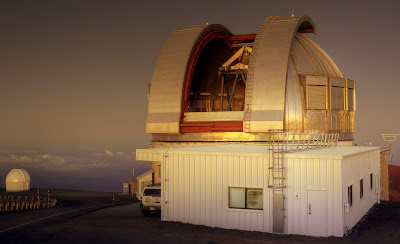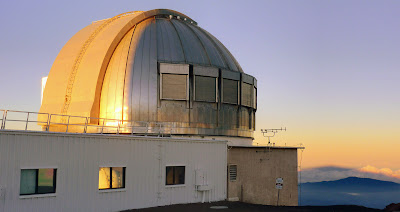 It's around 5:30 in the morning and it's time to take some calibrations. Non-astronomers/scientists reading this probably have no idea what I'm talking about or what the title of this post means!
It's around 5:30 in the morning and it's time to take some calibrations. Non-astronomers/scientists reading this probably have no idea what I'm talking about or what the title of this post means!In the old days astronomers used to take pictures of the night sky using film or photographic plates. As an undergraduate I remember taking several pictures using glass plates and then developing them in a dark room only to find my mistakes when it was too late! These days just about every professional astronomical observatory uses electronic detectors instead of film. Optical telescopes use CCDs (similar to those in your digital camera) and us infrared stalwarts use infrared arrays, although essentially the physics is the same. The detectors convert photons into electrons which are then used to create a picture.
Although not such a big problem with optical CCDs, infrared arrays tend to have noticeable differences in the efficiencies and gains of each pixel on the array. In our case, we use four 2048x2048 pixel arrays (that's nearly 17 million pixels) all of which have slightly different responses to light. Unless the detectors are calibrated the result of looking at a nice uniform piece of night sky would result in varying brightnesses across the final images and not a real representation of what we're looking at.
To correct for that we take flatfields; the arrays are exposed to a uniform light source and the pixel-to-pixel variation can be mapped and corrected for. In many of the instruments I've worked on before this is done using a light source within the instrument, but this can't be done with WFCAM or indeed most imaging instruments, so the bright twilight sky is used instead.
Taking these flats is not a favourite task for our staff at the telescope or the observer. At the end of a long night (12-13 hours in the winter) all you want to do is get down to a lower altitude, have a little breakfast and go to bed, but these calibration data are essential. We've tried using the sunset sky as a flatfield but the results haven't been good, probably due to instabilities caused by a warm dome which is quickly cooling down at the start of a night although I'll admit I really don't understand why this should affect flatfields. Just before sunrise, however, everything is in thermal equilibrium and so this is the time to take the calibration data. It doesn't take too long - 15 minutes or so at worst - and we make sure this is only done a few nights per month just to keep our staff sane!
 At 6am the sun is up, the dome is safely closed and the observers are probably just arriving at Vacation Resort Hale Pohaku (HP) for breakfast. It's a very quiet time at the summit because all the astronomers have left and apart from a very small number of tourists and a ranger, I'm the only one up there watching the shadow of the mountain slowly sink behind Hualalai.
At 6am the sun is up, the dome is safely closed and the observers are probably just arriving at Vacation Resort Hale Pohaku (HP) for breakfast. It's a very quiet time at the summit because all the astronomers have left and apart from a very small number of tourists and a ranger, I'm the only one up there watching the shadow of the mountain slowly sink behind Hualalai.Oh, enough of this nonsense, it's time to head down for bacon and eggs at HP!



2 comments:
Tom,
You really need to publish a book of your photos. Don't forget the narrative. Your prose and pictures are equally artistic.
Chuck
Chuck - really great to hear from you again! I hope you're doing well.
I'd love to publish a book one day but I can't - I'm not allowed to profit from the pictures I take on the summit. Maybe that'll change one day but I do appreciate your compliments!
Tom
Post a Comment